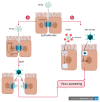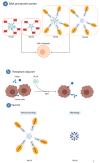The Adenovirus Dodecahedron: Beyond the Platonic Story
- PMID: 32630840
- PMCID: PMC7412204
- DOI: 10.3390/v12070718
The Adenovirus Dodecahedron: Beyond the Platonic Story
Abstract
Many geometric forms are found in nature, some of them adhering to mathematical laws or amazing aesthetic rules. One of the best-known examples in microbiology is the icosahedral shape of certain viruses with 20 triangular facets and 12 edges. What is less known, however, is that a complementary object displaying 12 faces and 20 edges called a 'dodecahedron' can be produced in huge amounts during certain adenovirus replication cycles. The decahedron was first described more than 50 years ago in the human adenovirus (HAdV3) viral cycle. Later on, the expression of this recombinant scaffold, combined with improvements in cryo-electron microscopy, made it possible to decipher the structural determinants underlying their architecture. Recently, this particle, which mimics viral entry, was used to fish the long elusive adenovirus receptor, desmoglein-2, which serves as a cellular docking for some adenovirus serotypes. This breakthrough enabled the understanding of the physiological role played by the dodecahedral particles, showing that icosahedral and dodecahedral particles live more than a simple platonic story. All these points are developed in this review, and the potential use of the dodecahedron in therapeutic development is discussed.
Keywords: Adenovirus; Dodecahedron; Platonic solids; Receptors; Structure; Vaccines; Viral spreading.; Virus Like Particles.
Conflict of interest statement
The authors declare no conflict of interest.
Figures






References
Publication types
MeSH terms
Substances
Grants and funding
LinkOut - more resources
Full Text Sources

